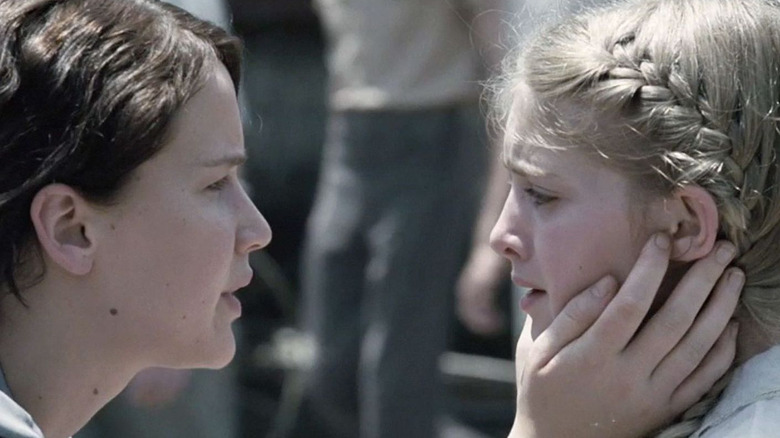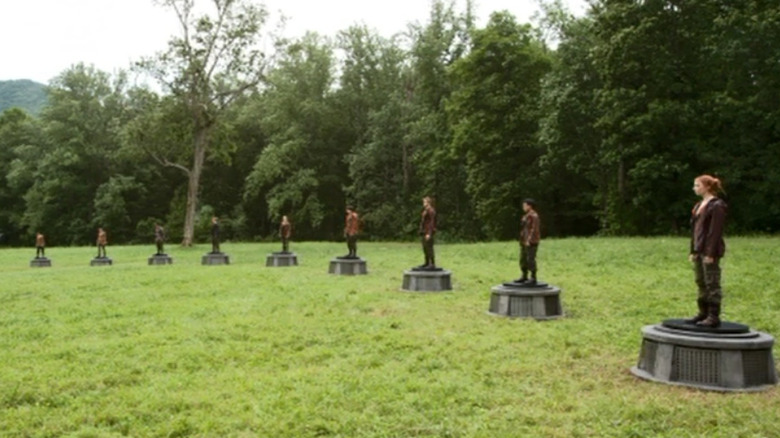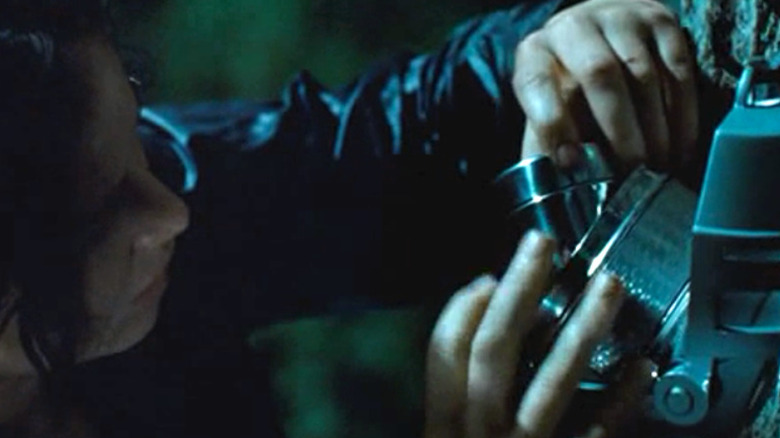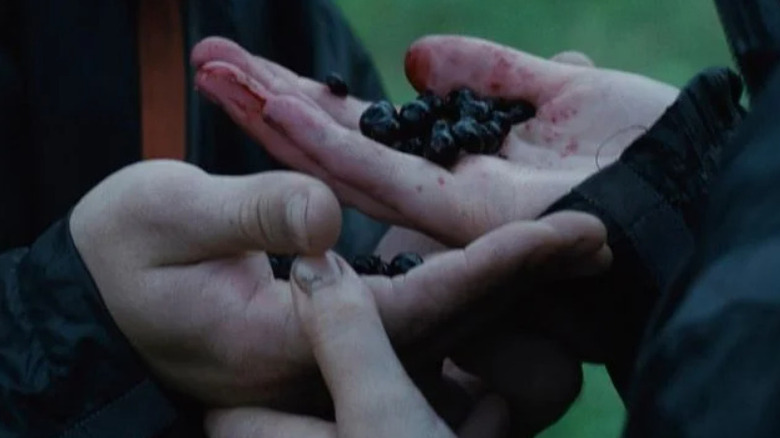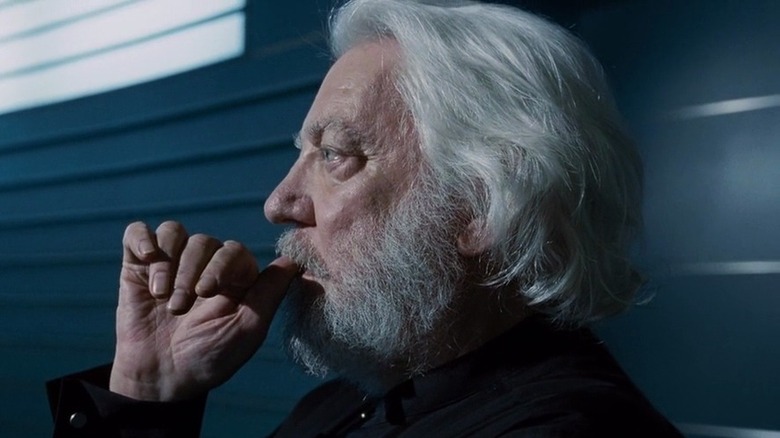Every Hunger Game Rule The Tributes Have To Follow Explained
The past two decades have been very light on female-led action franchises. "The Hunger Games" trilogy is one of the few bright spots in that regard, telling the story of Katniss Everdeen (Jennifer Lawrence), who becomes the leader of a rebellion in a post-apocalyptic world that wants to overthrow the oppressive government.
"The Hunger Games" films are based on the novels of the same name written by Suzanne Collins. While there are certain inevitable deviations from the books in their cinematic adaptations, the basic story remains the same. In the distant future, the North American country of Panem is divided into 13 districts controlled by the wealthy Capitol.
Each year, two teenagers from each of the first 12 districts, a boy and a girl known as "tributes," are chosen to take part in an event called the Hunger Games in which the tributes must battle each other to the death. The details of the Games, how they affect the society at large, and how the tributes eventually rise against the Capitol make up the rest of the trilogy. Let's take a look at 14 rules that the participants in the Hunger Games are forced to follow in their quest to become champion. Warning: Spoilers ahead.
Tributes are randomly chosen, or can volunteer
Participation in the Hunger Games is not a choice for the 12 districts, but a requirement. To that end, the creators of the Games, known as the "Gamemakers," came up with a system of random selection that would give every eligible entry from a district a chance at representing their community in the Hunger Games.
The selection process works like a grotesque lottery game. The names of the contenders from a district are written on slips of paper and kept in a transparent container called a "Reaping ball." There are two balls, one containing the names of all the boys and the other carrying the names of the girls. Two names are selected at random from the balls, and they are the tributes who will represent the district in the Hunger Games.
Under the "Tesserae" system, a candidate can have multiple slips of paper with their name on them added to the Reaping ball. This increases their chances of being chosen as a tribute. In return, the candidate qualifies for a year's supply of grain and oil for a single person, collected on a monthly basis. Finally, a candidate can volunteer of their own free will to become a tribute, which is what the story's heroine Katniss Everdeen did after her little sister Prim's name came out of the Reaping ball in the first part of the trilogy.
You only get a week's worth of training
Considering that most of the tributes who regularly become a part of the Hunger Games are teenagers from the poorest districts of Panem, there is not much scope for prior experience in the ways of warfare. All they have in terms of getting ready for the Games is a week's worth of time in a training facility.
In that one week, the tributes are expected to make the best preparations they possibly can to scope out the competition and come up with a plan to survive the Games the longest. The tributes can also practice fighting and using weapons, but there isn't nearly enough time to become proficient in their use if they have not had any practice beforehand.
There is a reason the tributes are given so little time to prepare. The Hunger Games are primarily a source of entertainment for the Capitol, and the last thing they want is for the tributes to become seasoned warriors who might give them extra trouble. It is much easier (and more entertaining) to keep the bewildered tributes as inexperienced as possible and give them just enough prep time to be able to kill the others in a desperate attempt to win the Hunger Games.
You cannot fight each other in the training area
Naturally, there are those tributes who would like to get an early start on winning the Games by eliminating the competition during the training period. But this is strictly not allowed. As mentioned before, the whole point of the Hunger Games is to give the audiences a spectacle unlike any other.
To that end, the tributes are only allowed to attack each other after having entered the official arena, where secret cameras record every stage of the battle for the entertainment of the masses. In order to prevent any suicide attempts the training and living area of the tributes are enclosed with a force field.
Since any sort of active aggression is not permitted, the tributes use this time to scope out the competition and identify any weaknesses that could be used later. The tributes also indulge in psychological warfare by trying to intimidate the others with a show of strength or brutality. The process leaves the tributes primed and ready to tear each other apart once the Hunger Games actually begin.
There is a grooming period
While the Hunger Games are a brutal system of oppression, they are presented as a fashionable sport. Consequently, the tributes are presented to the public as glamorous reality TV stars that the districts can cheer for, rather than the reality of them being trapped prisoners forced against their will to fight each other to the death.
Once the tributes are selected, they are taken to the Capitol, where they are given stylish makeovers. The tributes are also subjected to parades, interviews, and any other activity that the Gamemakers can come up with to drum up interest in the Games. At the end of the grooming and training period, each tribute is assigned a score from 1 to 12.
The scores are a way of giving the audiences an estimate of each tributes' chance of surviving the Games based on likeability, combat skills, intelligence, and various other factors. On the eve of the Games, the tributes make one final appearance before the audience in which they can try to win support from potential sponsors that might prove to be of invaluable use inside the arena.
You get a mentor
Before joining the Hunger Games, most of the tributes receive very little education or any sort of personal development lessons in their own districts. After becoming tributes, they have to represent their districts on a national stage in the biggest battle of their lives. To help them acclimatize to the challenge, tributes are assigned special mentors.
These mentors are usually victors of past Hunger Games. For the 74th and 75th Hunger Games, Katniss and Peeta had a joint mentor named Haymitch Abernathy (Woody Harrelson). He was the only Hunger Games victor from District 12 who was still alive after having won the second Quarter Quell. Unfortunately, Haymitch's horrific experiences as a tribute and later Hunger Games champion had turned him into a paranoid alcoholic who slept with a knife in his hand and refused to let anyone into his house.
While Haymitch might not seem like the best choice for a guide, the mentors can play an important role in the success of their respective tributes. "Your mentor is your lifeline to the world in these games," Effie Trinket explained at one point. "The one who advises you, lines up your sponsors, and dictates the presentation of any gifts. Haymitch can well be the difference between your life and your death!"
You can keep a non-weapon token
Most of the people from the 12 districts have precious little in their lives that they can call their own. But tributes are allowed to take one small item from their district on their journey into the Hunger Games. These items are called "tokens," and they are supposed to represent each tributes' district and also serve as a reminder of home.
The thing about choosing a token is that it must not be something the Gamemakers deem could provide an advantage to the tribute during the Games. For instance, during the 74th Hunger Games, Glimmer from district 1 tried to pass her ring off as a token but had it confiscated from her after it was revealed to contain a poison spike that could be released by twisting its gemstone.
On the other hand, Katniss wore her famous golden mockingjay pin during the Games. At first, the pin was almost taken as well since its sharp end could be a potential weapon, but the token was finally cleared by the Gamemakers. The mockingjay pin later became the adopted symbol of the rebellion and inspired waves of mutiny among the districts.
The calm before the storm
It's a pretty awkward thing to march into a battle arena with the intention of murdering every other tribute in the game that you spent the last week with. It can be difficult to decide how to get the ball rolling in such a scenario. To give everyone time to adjust, no one is allowed to fight each other in the first minute after the tributes are released into the battle arena on separate platforms.
In that first minute, the tributes are allowed to get their bearings and scan the area around them to decide on a plan of attack. If a tribute gets overexcited and steps off their platform before the minute is up, land mines embedded in the ground immediately take them out of the equation. The land mines are highly sensitive and can explode without warning at the slightest provocation.
There was even an incident in which a tribute accidentally dropped her token (a wooden ball) while standing on her platform, and the resulting explosion was so intense her body parts had to be "practically scraped off the ground." Once the first minute is up, a cannon fires, and after that, it is every tribute for themselves as the Hunger Games begin in earnest.
You can get supplies in the middle of the Games
Online multiplayer battle royale game enthusiasts are already familiar with "airdrops," which are food and ammunition supplies that are dropped into the battle area in the middle of a match. Something similar happens during the Hunger Games when sponsors are allowed to send crucial supplies to their favored tributes.
These sponsors are the reason why the tributes take so much trouble to ingratiate themselves with their audience before the Games begin. People from the Capitol send gifts and donations to whichever tribute strikes their fancy, while people from each district also try to scrape together enough funds to provide useful airdrops to their representative tribute. The cost of sending gifts increases the longer the Games continue.
The airdropped materials can be anything from a knife or a box of matches to food and medicine. The gifts are passed to the tributes' mentors, who get to decide when to send the gifts into the arena for maximum profit. Haymitch was even able to communicate with Katniss through the rations he sent her during the Games, and Katniss followed his advice to play up her "star-crossed lovers" act with Peeta to gain sympathy from the sponsors.
Don't cheat
This one can seem like a no-brainer. But when your life is literally on the line, it is inevitable that some tributes try to skirt the rules of the Hunger Games in a desperate attempt to gain an advantage. If the Gamemakers catch you indulging in any sort of rule-breaking, the punishment is swift and brutal, even though they can make the demise of a tribute look like a natural disaster instead of an execution.
Other times, the Gamemakers don't even try to be subtle. For instance, Haymitch was deemed a rule-breaker when he used the force field around the battle arena to take out the competition when he participated in the Hunger Games. While Haymitch was allowed to claim a victory, the next few days showed the cost of that victory. "My mother and younger brother. My girl," Haymitch explained at one point. "They were all dead two weeks after I was crowned victor. Because of that stunt I pulled with the force field."
When Katniss pulled the stunt with the poisonous berries to claim a double victory with Peeta, the Gamemakers allowed them to be crowned joint victors only because there was no one else left alive. The incident was deemed a major failure on the part of the Gamemakers, and Head Gamemaker Seneca Crane was killed for allowing such a major upset in the history of the Hunger Games.
Do not challenge the Capitol
By now, it should be clear that far from being a prestigious contest between the districts, the Hunger Games are nothing more than a show of strength by the Capitol and a warning to the districts to always toe the line and know that any sort of resistance is futile.
In that spirit, the biggest "no-no" when it comes to the Games is the tributes using their position to mock the Capitol in any manner. If the tributes cheat, that flouts the authority of the Capitol, and they are swiftly eliminated. If the tributes refuse to compete, that flouts the authority of the Capitol, and they are swiftly eliminated. If the tributes protest the way the Games are run in front of their audiences, that flouts the authority of the Capitol and... you know the rest.
That is why Katniss Everdeen became such a thorn in the side of the people in charge at the Capitol since she consistently found ways to engage in public displays of defiance towards the Capitol. That was also why she emerged as a popular symbol of resistance once the secret rebellion against the Capitol started in earnest and the various districts needed a central rallying point to get behind.
No cannibalism
Once you strip away the parades and the fashion shows and the interviews, the Hunger Games stand exposed as a horrifically brutal method for the Capitol to display their power over the 12 districts by having their children maim, torture, and kill each other for the amusement of the masses.
As the games progress, the tributes go to increasingly extreme lengths to intimidate and eliminate the competition. Some, like Peeta, have a difficult time embracing the violence. Others, like Katniss, resign themselves to committing horrific acts in the name of survival. And then there was Titus, a tribute who participated in a previous Hunger Games. Titus was driven half-mad by the brutality he witnessed and took to eating the hearts of the other tributes that he killed as a show of dominance.
The audiences drew the line at cannibalism, and the Gamemakers had to censor Titus' kills and electrically stun him to retrieve the bodies of his victims. It is implied that the Gamemakers had Titus killed in an avalanche to make sure he would not win the Games. After that, the "no cannibalism" rule was implemented to ensure that final moral line was never crossed again by the tributes.
Do not isolate yourself
Some tributes from certain districts spend their whole lives training for the Hunger Games and take to the competition with great zeal and enthusiasm. Others like Katniss are much more reluctant about the whole "child killing" aspect of the Games, and would prefer to stay out of the way of the other murderers until facing them becomes an absolute necessity.
Unfortunately, this sort of behavior does not make for exciting television, and the Gamemakers do not allow for it. In a past edition of the Hunger Games, Haymitch managed to win by staying near the outskirts of the arena near the surrounding force field.
The Gamemakers learned from that example, and in future Games, the tributes are not allowed to dawdle near the force field for too long. That is why in the first novel, when Katniss reached the edge of the arena several kilometers away from the other tributes, the Gamemakers set off a forest fire to force her to turn back.
There can be only one victor
Many of the other rules on this list are not explicitly spelled out in a "Hunger Games" rulebook but rather implied by the Gamemakers to ensure no one cheats or misbehaves during the games. In the end, there is only one major rule that the entire event centers around: Whoever kills all the other tributes first wins.
It is this rule that powers most of the drama surrounding the games, as Katniss, Peeta, and some of the other tributes struggle with the idea of killing their peers in order to survive. The "sole-survivor" rule is also what kickstarts the events of the future rebellion against the Capitol once Katniss finds a way to circumvent the rules to ensure both she and Peeta are named co-victors of the Hunger Games.
At the end of the day, leaving a single surviving victor allows the Capitol to prop the tribute up as a "champion" of the 12 districts while also sending a warning that the Capitol decides who lives and who dies among the people belonging to the districts. This is meant to be an annual punishment inflicted on the people of the districts in case they ever want to try starting another rebellion like the one in the past that allegedly wiped out District 13.
The victory lap
You have participated in the Hunger Games. After a brutal free-for-all, you have finally managed to eliminate all the other tributes and been named the winner of the Hunger Games. So now what? For the tribute who survives, victory is as glamorous as the "grooming" period before the start of the Games and just about as hollow.
Roughly six months after emerging from the battle arena, the winner is decked out in their best clothes from the pre-Games parade and taken on a "Victory Tour" across all the districts of Panem, starting at District 12 and going in descending order to stop at 1. The district the winner belongs to is saved for last, where a giant feast is held in their honor so all the people of the district can eat their fill.
While the purpose of the Victory Tour is ostensibly to celebrate the tribute winning, its real purpose is to remind the losing districts about the loss of their children to the Games. That is why the tribute who wins is often consumed by feelings of guilt and shame over having to go on the Tour and face the family and friends of the other tributes that they were forced to murder.

